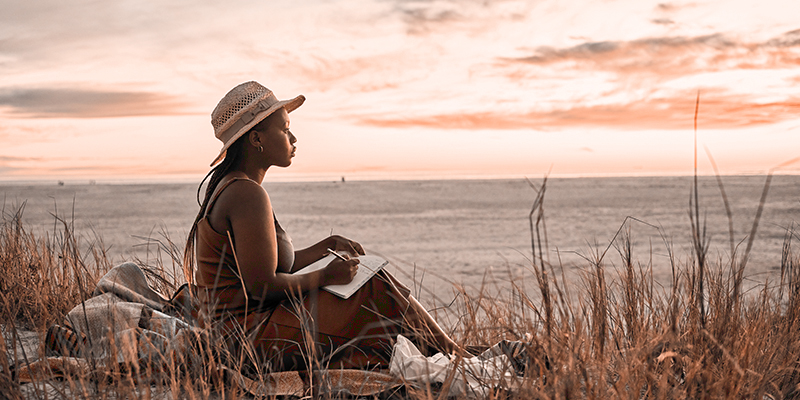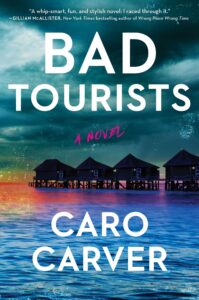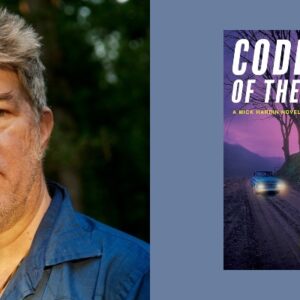A long time ago, I let a friend talk me into going scuba diving in the Great Blue Hole in Belize. I did not have a PADI license. I had never so much as touched a scuba mask, had never been diving, and should absolutely not have agreed to do my first (did I mention unlicensed?) dive where the underwater drop is 400 ft deep and teeming with sharks. Also, I was very short-sighted back then (it was a few years before I had laser eye surgery) and had to remove my glasses for the snorkel mask. Unexperienced, blind, and hundreds of feet beneath the surface, I began to panic. But amidst all of this, I remember thinking—this would make a great scene for a novel.
I’ll not give too much away about how this experience translated, but suffice it to say that (a) I survived my frankly reckless first dive and (b) I used the experience for a scene in my current novel, Bad Tourists. While the book is set in the Maldives, my memories of my first and last scuba diving trip came in handy for a particular scene, as did visiting the Maldives just before I started writing. Wherever I possibly can, I visit the places where I set my novels. I now swear by this method. While I travelled extensively as a student, my years spent raising young children were spent close to home. But when my youngest child was about six, I received a travel grant to research a novel set in Norway. It was great news, but still I felt torn about leaving for two weeks—was it necessary that I go? Maybe internet research was enough—YouTube has so much content, after all… But with the encouragement of my family, I set off to explore the Arctic Circle.
I cannot express how transformative this experience was. It wasn’t just the experience of twenty-two hours a day of midnight, or being on a ship surrounded by snow-encrusted islands. It wasn’t the delight of an Arctic fishing village with sixty inhabitants, or visiting a Viking grave or seeing the northern lights. It was immersing myself in the world of the novel and opening up to insights about Norwegian culture, history, language, environment, politics, and society. Details I never would have found on the internet sparked fragments of plot and whole narrative threads. It was the experience of writing from a place of deep curiosity and wonder.
Still, I am a writer, not an oil billionaire, and finding childcare for four school-age children and time away from my full-time job to research novels set abroad is no easy feat. Travel grants are a boon, but hard to come by. Despite learning many useful ways as a student on how to travel on a shoestring budget, I’m ever aware of my privilege when it comes to travel, as well as the cost to the environment. And so I’m careful, and cautious, about how much I travel in general. For Bad Tourists, I originally went to the Maldives not to write, but to celebrate a milestone wedding anniversary, and it took a week in the glorious, pounding heat of the Vaavu Atoll for this Scotland-based writer to recall what sunlight felt like. I had actually toyed with setting Bad Tourists in Iceland (!), a place I love, but hoo boy, that idea got knocked right on the head the moment I sat down on a sun lounger overlooking the glittering turquoise expanse of the Indian Ocean. What followed was six days of absorbing sunlight and bringing hazy narratives to life with punch and verve. In the environment of the story (admittedly with my out-of-office on and my brain no longer churning mental to-do lists), my characters quickly told me who they were and what they wanted. I understood them and their motives, and how they might act in this sweltering heat, on an island cut off from their frenetic, urban lives. The island’s talc-white sand, the roof-sized palm trees and the orchid-strewn paths that led to massage studios or kayak shelters, the spell-binding view of Indian Ocean, the dramatic sunsets, shrieking bats, scuttling hermit crabs, and shy nurse sharks that nosed the jetty—all infused my story with a vivacity and dazzling authenticity that I would never have achieved from my home office in Glasgow. It gave me confidence to take risks with plotlines, and venture into narrative territories I probably would have left untapped.
Spurred on by just how fruitful my Maldives trip had been, I decided to visit the setting of my next book. And so, in April this year, after a two-hour flight from Edinburgh and a forty-minute ferry from Naples, I arrived on the stunning island of Capri. The glistening Bay of Naples, the football-sized lemons, the golf carts that zip through the narrow, cobbled streets which are inaccessible to cars all unfolded ideas and the first whispers of dialogue. Perhaps most important of all, I came across a hotel that was virtually identical to the one I had imagined for the story. The hotel in this book – published next year – plays a huge role in terms of the plot, and so coming across the astonishing Caesar Augustus Hotel perched on a cliff high above the Marina was a stroke of luck. The 1930s wooden elevator, marble bathtubs, olive groves, and the winding zero-mile vegetable garden all crept into the story, just like the Maldives had in Bad Tourists.
As much as time, money, health, and the environment allows, I swear by the method of visiting the place where my destination thrillers are set. I like to think I’m throwing myself in the way of story, soaking up whatever happenstance events come my way, gathering secrets buried in conversations with residents, or gems of local knowledge. In practice, this is writing-as-exploring, collecting a treasure trove of encounters and ideas that spark little fires throughout the writing process, and which prompt me to explore a particular detail further. I’ve learned to put aside my expectations of a place and distrust what the internet shows —there really is so much more to be found in person.
***


















